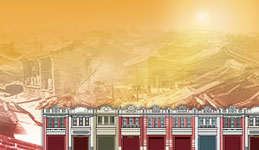|
 Control of Light
Control of Light
Wu-fu street was a product of late commercial development in Lukang, and
the meteorological factors is of greatest concern. In addition to
preventing from rain and shine, the design of the roof also considered
about the air, light and drainage works. To block out the sunshine and
rain, the height of roof is about two meters for the purpose of
comfortable shopping environment. As to the drainage work, all the water
is collected by the pipe on the roof led to the end of the street. The
light, creating by skylight or gap, makes customers to be able to shop
brightly in the street.
To drain water from the roofs in rainy days, the top of the pavilions
built by the stores were two meters higher than the roofs of the stores.
When it rained, the rain was gathered from the roofs of the stores
beside the street and then went to the ditch by pipe. This way of
carefully taking care of skylights, ventilation, and drainage rid
pedestrians of their suffering of storms and effectively solve the
problem of dirty water so that the “no sky” market area was neither dark
nor humid at all. No wonder the famous scholar in Cing Dynasty,
Hong Ci-Sheng described “no sky” in his poetry as follows :
" Of all the houses of street, frontispiece of every house varies.
The houses, opposite to each other, hath lighthouse for their own.
The road, in crescent moon shape, lasted for one or two miles.
The ground, flat as a smooth stone,
hath a delight to walk on
The clothes of customers never sweat in the summer
days,
Nor
it happened in rainy days that they wet their shoes."
|



